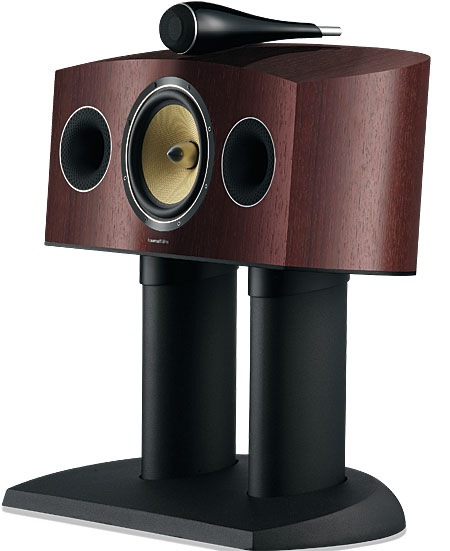Bowers & Wilkins 805 Diamond Speaker System Page 2
On the curved back panel are two pairs of biwire-capable speaker terminals. They are unique, with a knobby shape and oxygen-free copper innards. Unlike most biwire-capable speakers, these don’t ship with stamped metal bridges installed. The company provides banana-plug-terminated jumpers with the speakers.

The HTM4 Diamond center-channel speaker came as a pleasant surprise. Normally, I am suspicious of horizontal center speakers. Even when their drivers and crossovers match those in the other speakers, the use of parallel double woofers can cause off-axis lobing (summation and cancellation effects). But this particular center uses exactly the same vertical driver configuration as the 805D, just in a wide, horizontal cabinet with two ports on the front. As I found out later, the result is consistent timbre matching across the three front channels. The rated frequency response of the HTM4 and 805D are exactly the same: 49 hertz to 28 kilohertz +/–3 decibels. Would the extra port or different enclosure shape show up in our measurements? Read them and see.
In addition to the rich Piano Black of our review samples, the 800 Diamond Series is also available in Rosenut and Cherry veneers. Aluminum trim rings provide decorative accents. The cabinets are manufactured at Bowers & Wilkins’ factory in Worthing, England.
Finally, the ASW 12CM subwoofer packs a 12-inch front-firing driver into a sealed Piano Black enclosure that’s only a little bigger than the driver itself. It offers some relatively rare features. The Bass Extension switch offers three tradeoffs between bass extension and bass output. The A position provides the most extension, B is a compromise, and C offers the most output. I opted for the most extension. There’s also a Bass EQ switch with two settings. One is what the manual calls a “drier alignment” that’s suitable for corner sub placement or rooms with an objectionable resonant frequency. The other is suitable for non-corner placement or rooms with less of a bass hump. Although I don’t use corner placement, my room has a notable resonant frequency, so I opted for the first setting. The sub also has a 12-volt trigger and a crossover bypass, which lets you set the crossover in your A/V receiver or surround processor.
Associated equipment included a Rotel RSX-1550 A/V receiver, OPPO BDP-83SE universal disc player, Rega Planar 25 turntable, Shure M97xE cartridge, and Bellari VP530 phono preamp. All movie selections were Blu-ray Discs with DTS-HD Master Audio soundtracks.

Book of Revelations
If I say the 805D (and friends) was immensely source dependent, I don’t mean ruthlessly revealing, that coded critic-speak that refers to a product that makes a majority of things feel fatiguing and a few things sound great. The word revelatory serves the purpose better. Given a movie soundtrack of complexity and subtlety, the Diamond speakers are complex and subtle—not to mention powerful, sensuous, and pleasing. They could convey abrasiveness, vagueness, and other below-par elements, but without obscuring elements that were at or above par. They are adroit jugglers.
The Book of Eli is a post- apocalyptic Western that’s civilized by the presence of Denzel Washington as a contemplative but action-ready traveler who must convey a mysterious book from the badlands to civilization. The Diamond Series had a lot to do, peeling back the layers of music and effects without denying them their cumulative impact. With matched tweeters-on-top all around, the speakers effortlessly tracked the placement and movement of every element. It did so with no unevenness across the front or between front and back. The aural landscape was given to sudden dynamic and tonal transformations, with mellow music succeeded by chain-saw assaults. In this case, chain saws were literally involved, and the 805D system didn’t soft-pedal their vicious buzz. Gunshots had a distinctive and not unpleasant crack that varied from scene to scene. Quieter moments were equally striking in terms of both resolution and dynamic subtlety, especially when Washington exercises his voice in a low murmur. The score signifies meaningful moments by suddenly stepping up the percentage of orchestral instruments. The Diamonds seemed to relish these transitions, as though they’d spent a lot of time in concert halls. I noticed that I was actually identifying with the hardware: It seemed to have become a part of me, a strange merging of reviewer and review subject.





























































